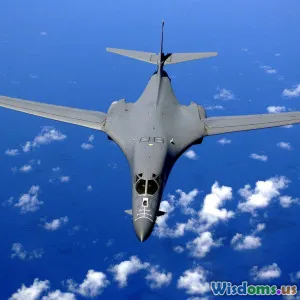
Lessons Learned From the Most Costly Data Breaches in Defense
13 min read Explore key lessons from major defense data breaches to strengthen cyber defense and prevent costly cyberattacks in military organizations. (0 Reviews)
Lessons Learned From the Most Costly Data Breaches in Defense
In the high-stakes world of national security, the consequences of a data breach extend far beyond the financial loss. When the defense sector—guardians of top-secret information, critical infrastructures, and strategic plans—falls victim to cyber intrusions, the impact can echo for years: eroding trust, undermining operations, and jeopardizing lives. However, past crises have also become catalysts for change, teaching hard-earned lessons that shape modern defense strategies. What can we learn from history’s most expensive defense data breaches?
The True Cost of Defense Data Breaches: More Than Dollars

When thinking about data breaches, headline figures often focus on the direct monetary loss. While figures like the $100 million estimated loss from the OPM breach or the billions in economic damage following defense contractor hacks are astronomical, money isn’t the whole story.
Take the 2015 U.S. Office of Personnel Management (OPM) breach. Attackers, linked to a nation-state, compromised personal details—including fingerprints and background histories—of nearly 21.5 million federal employees and contractors. The ripple effect?
- Espionage risks: Adversaries could identify and target undercover agents or high-ranking officials.
- Loss of competitive advantage: Military secrets and technical data in enemy hands compromise year-long, costly R&D efforts.
- Erosion of diplomatic trust: Allies and partners may become hesitant to share sensitive intelligence with compromised agencies.
These multifaceted losses highlight why defense breaches are uniquely catastrophic—and why preventing them requires a nuanced, multi-layered approach.
Case Studies: Not Just a Civilian Threat

Military and defense contractor cyberattacks draw global attention. Two notable examples reveal both common threads and unique challenges.
The OPM Breach: A Wake-Up Call
The 2015 OPM intrusion wasn’t the result of sophisticated "zero-day" exploits but rooted in poor cyber hygiene. Unencrypted data, outdated systems, and lack of multifactor authentication allowed attackers to spend months lurking unnoticed. When discovered, the exposure of clearance-sensitive fields had a psychological impact, shattering public trust.
Lockheed Martin and Contractors: Industrial Espionage in the Digital Age
Multiple U.S. defense contractors, including Lockheed Martin—makers of the F-35 fighter jet—have disclosed advanced persistent threat (APT) attacks linked to nation-state adversaries. In several instances, technical details related to weapons systems were leaked, leading to concerns such as:
- Accelerated development of rival technology (e.g., China’s J-20 stealth fighter resemblance to F-22 designs).
- Supply chain vulnerabilities, where subcontractors with weaker defenses become entry points.
These stories underline that everyone—from contractors to federal agencies—is a target.
Common Causes: Patterns Behind the Headlines

An analysis across the worst breaches reveals familiar causes, many of which can be proactively addressed:
1. Weak Authentication & Password Management
- Many breaches exploited weak, reused, or default passwords.
- Single sign-on without added security, and unencrypted data, simplified lateral movement.
2. Outdated Systems and Unpatched Vulnerabilities
- Legacy systems (“end-of-life” hardware, unsupported software) couldn’t be easily updated or secured.
- Unpatched, public-facing vulnerabilities ripe for exploitation (e.g., “ProxyLogon” in Microsoft Exchange).
3. Insufficient Segmentation & Monitoring
- Lack of segmentation meant once inside, attackers could freely access sensitive records and data vaults.
- Minimal network monitoring delayed breach detection; some defense breaches went undetected for months to years.
The lesson? No organization, regardless of mission or secrecy, is immune from basic cybersecurity oversights.
The Domino Effect: Supply Chains as Vulnerable Backdoors

A chain is only as strong as its weakest link. Modern defense ecosystems depend on sprawling supply chains involving thousands of contractors and subcontractors. Breaches here multiply risk:
- Targeting smaller vendors: Attackers infiltrated primary defense targets (like Lockheed Martin) via less-secure partners.
- Third-party software compromise: The infamous SolarWinds breach enabled hackers to piggyback on widely used network management tools—granting access to U.S. defense networks undetected for months.
- Challenges in vetting and oversight: Vetting an evolving network of suppliers, with varying levels of IT maturity, proves daunting. Especially problematic in industries racing to adopt cloud and IoT solutions.
Actionable advice: Regular supply chain audits, mandatory baseline cybersecurity certifications, and real-time vendor monitoring are now central to defense contracting.
Evolving Lessons: What Works and What Hasn’t

Past mistakes shouldn’t be repeated. Let’s break down key learnings adopted in recent years:
Shift to Zero Trust
Legacy network models assumed everything inside the perimeter was safe. Zero Trust flips this: "Never trust, always verify".
- Continual validation of user/device identity and access.
- Micro-segmentation, ensuring breaches in one zone don’t expose entire networks.
- Widely adopted post-OPM by the U.S. Department of Defense (DoD), now required for new systems.
Increased Focus on Insider Threats
Many high-profile breaches, like Chelsea Manning’s Wikileaks disclosure, occurred from within. Defense entities now focus on behavioral analytics, privilege restrictions, and rapid anomaly detection:
- Automated monitoring of data exfiltration attempts.
- Least-privilege access across all personnel.
- Regular reevaluation of clearances and roles.
Cybersecurity as a Team Sport
Recognizing that isolated efforts fail, there’s been a drive toward collaborative intelligence sharing and cross-agency coordination:
- Public-private intelligence partnerships (e.g., NSA’s Cybersecurity Collaboration Center).
- Red-teaming and independent penetration testing of critical assets.
- Continuous training and tabletop exercises to rehearse incident responses.
Best Practices: Actionable Strategies for Defense Organizations

Defense organizations have distilled key best practices to strengthen their digital fortresses:
1. Comprehensive Risk Assessment and Mapping
- Map data flows: Understand where sensitive data lives, moves, and is accessed across all partners and platforms.
- Identify crown jewels: Distinguish between high/low value information for prioritized protection.
- Continuous assessment: Treat risk as a living entity, not a checklist item.
2. Layered Security Architectures (Defense in Depth)
- Firewalls, endpoint detection, encryption, SIEM—no single solution is enough, but a coordinated mosaic of tools raises the bar.
- Implement strict network segmentation, limiting potential fallout of a compromise.
- Pair human vigilance (SOC analysts) with AI-driven threat hunting for advanced visibility.
3. Cultivate a Culture of Security Awareness
Human error remains an adversary’s top entry point. To counter this:
- Regular spear-phishing tests and mandatory training, focused on evolving adversary methods.
- Foster a culture where reporting potential vulnerabilities is rewarded, not penalized.
- Senior leadership involvement to emphasize that cyber awareness is mission-critical.
4. Rapid Detection and Incident Response Capabilities
A breach’s impact is often measured in dwell time—the longer intruders go undetected, the more severe the damage.
- Invest in expanded real-time monitoring and forensics capabilities.
- Institute regular red-team/blue-team exercises, with lessons integrated into updated playbooks.
- Ensure incident response teams have clear authority and resources to act at the first sign of trouble.
Preparing for the Next Threat: Adaptive Security and Resilience

As cyber warfare evolves, so too must defense postures. Flexible, resilient defense strategies demand:
- Continuous security testing: More defense agencies use "purple team" assessments—blending offense and defense—to reveal blind spots.
- Automated response protocols: AI and automated playbooks detect, contain, and mitigate attacks before humans can manually respond.
- Disaster recovery and continuity planning: The ability to swiftly restore critical functions—even after compromise—can blunt an adversary’s operational advantage.
Learning from Adversaries
Understanding adversary tactics—the techniques, tools, and procedures (TTPs) of attacker groups—has become essential. Intelligence-led defenses are now routine:
- Implement threat modeling based on real-world APT tactics.
- Use threat intelligence feeds to patch and compensate for emerging vulnerabilities proactively.
Tip: Regularly update adversary emulation plans; yesterday’s playbook won’t counter new, advancing threats.
Building a Lasting Security Legacy

While no defense agency is completely breach-proof, perseverance and adaptability set successful organizations apart. Each cyber crisis, though costly, seeds improvement for the next generation of defense leaders.
- Breaches like OPM’s forced unprecedented transparency and investment in modernization.
- Lessons from contractor compromises sparked industrywide cybersecurity tightening—from the DFARS regulations to CMMC certification in the U.S.
- Internationally, joint exercises, information sharing, and collective security treaties are building resilience not just in single agencies but alliances.
In the end, the enduring lesson from defense-sector data breaches is this: security is not a one-time project, but an ongoing mission. By rigorously examining past failures—and applying actionable, collaborative, and adaptive strategies—the defense industry can strive toward a future where trust and readiness are rebuilt, and hard-won lessons form the backbone of an ever-evolving security posture.
Rate the Post
User Reviews
Other posts in Cybersecurity
Popular Posts


















